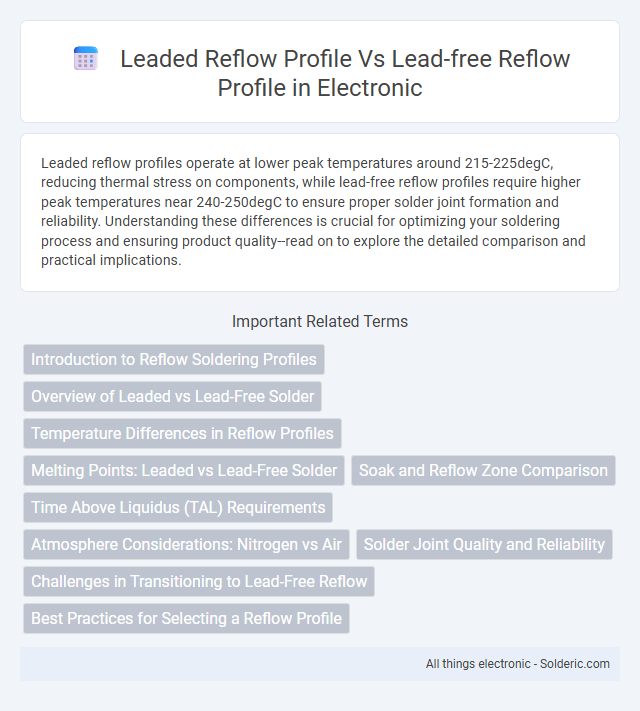Leaded reflow profiles operate at lower peak temperatures around 215-225degC, reducing thermal stress on components, while lead-free reflow profiles require higher peak temperatures near 240-250degC to ensure proper solder joint formation and reliability. Understanding these differences is crucial for optimizing your soldering process and ensuring product quality--read on to explore the detailed comparison and practical implications.
Comparison Table
| Parameter | Leaded Reflow Profile | Lead-Free Reflow Profile |
|---|---|---|
| Melting Point | 183degC (SnPb alloy) | 217-221degC (SAC alloys) |
| Peak Temperature | 215-225degC | 240-250degC |
| Ramp-Up Rate | 1-3degC/second | 1-3degC/second |
| Time Above Liquidus (TAL) | 30-60 seconds | 30-90 seconds |
| Preheat Temperature | 150-170degC | 150-180degC |
| Cooling Rate | 3-4degC/second | 3-4degC/second |
| Flux Requirement | Moderate activity flux | Higher activity flux |
| Equipment Stress | Lower thermal stress | Higher thermal stress on components |
| Environmental Impact | Contains lead - toxic | Lead-free - eco-friendly |
| Reliability | Established, proven process | Requires careful process control |
Introduction to Reflow Soldering Profiles
Reflow soldering profiles define precise temperature and time parameters crucial for melting solder and forming reliable electronic connections. Leaded reflow profiles typically have lower peak temperatures around 215-225degC, reducing thermal stress on components. Lead-free profiles require higher peak temperatures, often 240-250degC, to meet the melting points of lead-free solders, demanding careful thermal management to avoid damage.
Overview of Leaded vs Lead-Free Solder
Leaded solder typically contains tin-lead alloys, offering a lower melting point around 183degC, which results in shorter reflow time and reduced thermal stress on components during soldering. Lead-free solder, commonly composed of tin, silver, and copper (SAC) alloys, requires higher reflow temperatures ranging from 217degC to 240degC to accommodate its elevated melting point, demanding more robust thermal profiles. The choice between leaded and lead-free reflow profiles directly impacts PCB reliability, thermal management, and compliance with environmental regulations such as RoHS.
Temperature Differences in Reflow Profiles
Leaded reflow profiles typically peak between 215degC and 230degC, allowing for lower melting point solder alloys with shorter reflow times. Lead-free reflow profiles require higher peak temperatures, ranging from 235degC to 250degC, due to the higher melting points of lead-free solder alloys like SAC305 (Tin-Silver-Copper). These temperature differences critically impact PCB material selection and component thermal tolerance during the soldering process.
Melting Points: Leaded vs Lead-Free Solder
Leaded solder typically melts at a lower temperature, around 183degC (361degF), compared to lead-free solder which melts at approximately 217-221degC (423-430degF), depending on the specific alloy such as SAC305. The higher melting point of lead-free solder requires adjusted reflow profiles with increased peak temperatures and extended soak times to ensure proper wetting and joint reliability. This temperature difference impacts thermal stress on components and PCB materials, necessitating careful profile optimization for lead-free assembly processes.
Soak and Reflow Zone Comparison
The soak zone in leaded reflow profiles typically operates at lower temperatures, around 150-180degC, to gently stabilize components before reflow, whereas lead-free reflow profiles require higher soak temperatures, often between 180-210degC, due to the higher melting point of lead-free solder alloys. In the reflow zone, leaded solder melts at approximately 183degC, allowing for a shorter reflow time and lower peak temperature, whereas lead-free solders, such as SAC alloys, necessitate peak temperatures in the range of 230-250degC to achieve proper solder joint formation. This difference impacts thermal stress on components and PCB substrates, making careful profile adjustment critical to avoid defects like tombstoning or insufficient wetting.
Time Above Liquidus (TAL) Requirements
Leaded reflow profiles typically require a Time Above Liquidus (TAL) of 30 to 60 seconds at around 183degC melting point of the solder alloy, ensuring proper wetting and joint formation. Lead-free reflow profiles demand a longer TAL, often between 60 to 90 seconds at approximately 217degC melting point due to higher melting temperatures of lead-free solder alloys like SAC305. Precise control of TAL is essential in both profiles to prevent insufficient solder joint reliability or thermal damage to components.
Atmosphere Considerations: Nitrogen vs Air
The leaded reflow profile typically tolerates air atmosphere due to its lower processing temperatures, which reduces the risk of oxidation. Lead-free reflow profiles require a nitrogen atmosphere to minimize oxidation and improve solder joint quality, as higher peak temperatures increase oxidation rates. Using nitrogen in lead-free reflow ensures reliable soldering by protecting Your components from oxidation-related defects.
Solder Joint Quality and Reliability
Leaded reflow profiles typically operate at lower peak temperatures around 215-225degC, resulting in reduced thermal stress on components and improved solder joint quality with fewer defects such as voids and cracks. Lead-free reflow profiles require higher peak temperatures, often between 240-250degC, to ensure proper solder wetting, which can increase the risk of component warping and decrease long-term reliability due to accelerated intermetallic growth. Optimizing the thermal profile for lead-free solder is critical to balance mechanical strength and minimize reliability issues in high-temperature environments.
Challenges in Transitioning to Lead-Free Reflow
Transitioning to lead-free reflow profiles presents significant challenges including higher melting temperatures, which can stress printed circuit boards and components, leading to potential warping or damage. The absence of lead requires precise temperature control and extended soak times to ensure proper solder joint formation and reliability. Additionally, adapting existing leaded reflow profiles demands careful process calibration to prevent defects like tombstoning and insufficient wetting in lead-free soldering.
Best Practices for Selecting a Reflow Profile
Selecting the optimal reflow profile requires understanding the thermal characteristics of leaded versus lead-free solder alloys, as lead-free solders typically demand higher peak temperatures around 240-250degC compared to leaded solders at 215-230degC. Best practices include precisely controlling the soak time to activate flux without damaging components, maintaining a controlled ramp rate of 1-3degC/sec to minimize thermal stress, and ensuring a rapid cooling phase to solidify solder joints effectively while preventing defects. Profiling with thermal imaging and adjusting based on component sensitivity optimizes solder integrity, yields, and reliability for both leaded and lead-free assemblies.
Leaded reflow profile vs lead-free reflow profile Infographic

 solderic.com
solderic.com